TL-SG3424P specifications
The TP-Link TL-SG3424P is a high-performance managed switch designed to meet the needs of small to medium-sized businesses. Offering 24 Gigabit Ethernet ports, this device is an ideal solution for improving network efficiency and ensuring seamless data transfer across multiple devices. The switch not only facilitates connectivity but also provides robust management features to enhance the performance and security of your network.One of the standout features of the TL-SG3424P is its Power over Ethernet (PoE) capability, which allows it to deliver power and data over the same Ethernet cable. This feature is particularly beneficial for deploying devices such as IP cameras, VoIP phones, and wireless access points without the need for additional power sources. With a total power budget of 250W, the TL-SG3424P can support a diverse range of PoE devices, providing convenience and flexibility in deployment.
In terms of management, the TL-SG3424P offers a user-friendly web interface, allowing network administrators to configure and monitor the switch with ease. It supports advanced Layer 2 features, including VLANs, Quality of Service (QoS), and Link Aggregation. These features enhance network performance by optimizing traffic flow and prioritizing essential applications. The switch also includes comprehensive security features, such as Port Security and Access Control Lists (ACL), which help protect against unauthorized access and ensure data integrity.
The build quality of the TL-SG3424P is robust, designed to handle demanding network environments. It includes a fanless design, which ensures silent operation, making it suitable for office environments where noise can be a distraction. The metal chassis is durable and built for longevity, ensuring that the device will withstand rigorous usage over time.
Furthermore, the TL-SG3424P supports SNMP (Simple Network Management Protocol), allowing for centralized network monitoring and management. This makes it easier for IT teams to keep track of network health and performance, enabling timely interventions when necessary.
In conclusion, the TP-Link TL-SG3424P is a versatile and powerful managed switch that combines PoE capabilities with advanced network management features, making it a perfect choice for businesses looking to upgrade their network infrastructure. With its reliable performance and robust features, it provides an excellent solution for enhancing productivity and connectivity in any office setting.
